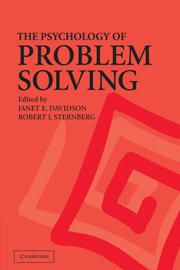Book contents
- Frontmatter
- Contents
- Contributors
- Preface
- PART I INTRODUCTION
- PART II RELEVANT ABILITIES AND SKILLS
- PART III STATES AND STRATEGIES
- 8 Motivating Self-Regulated Problem Solvers
- 9 Feeling and Thinking: Implications for Problem Solving
- 10 The Fundamental Computational Biases of Human Cognition: Heuristics That (Sometimes) Impair Decision Making and Problem Solving
- 11 Analogical Transfer in Problem Solving
- PART IV CONCLUSION AND INTEGRATION
- Index
- References
11 - Analogical Transfer in Problem Solving
Published online by Cambridge University Press: 05 June 2012
- Frontmatter
- Contents
- Contributors
- Preface
- PART I INTRODUCTION
- PART II RELEVANT ABILITIES AND SKILLS
- PART III STATES AND STRATEGIES
- 8 Motivating Self-Regulated Problem Solvers
- 9 Feeling and Thinking: Implications for Problem Solving
- 10 The Fundamental Computational Biases of Human Cognition: Heuristics That (Sometimes) Impair Decision Making and Problem Solving
- 11 Analogical Transfer in Problem Solving
- PART IV CONCLUSION AND INTEGRATION
- Index
- References
Summary
When people encounter a novel problem, they might be reminded of a problem they solved previously, retrieve its solution, and use it, possibly with some adaptation, to solve the novel problem. This sequence of events, or “problem-solving transfer,” has important cognitive benefits: It saves the effort needed for derivation of new solutions and may allow people to solve problems they wouldn't know to solve otherwise. Of course, the cognitive benefits of problem-solving transfer are limited to the case in which people retrieve and apply a solution to an analogous problem that, indeed, can help them solve the novel problem (positive transfer). But people might be also reminded of and attempt to transfer a solution to a nonanalogous problem (negative transfer) and thereby waste their cognitive resources or arrive at an erroneous solution. The challenge facing researchers and educators is to identify the conditions that promote positive and deter negative problem-solving transfer. In this chapter, I describe how researchers who study analogical transfer address this challenge. Specifically, I describe work that examined how problem similarity affects transfer performance and how people determine whether the learned and the novel problems are similar. Throughout the chapter I highlight the relevance of research on analogical transfer to instructional contexts and illustrate the main concepts and findings with examples of mathematical word problems.
SIMILARITY IN SURFACE AND STRUCTURE
As in every other case of learning generalization, the main variable that mediates problem-solving transfer is the degree of similarity between the learned (base) and novel (target) problems.
- Type
- Chapter
- Information
- The Psychology of Problem Solving , pp. 343 - 370Publisher: Cambridge University PressPrint publication year: 2003
References
- 18
- Cited by

